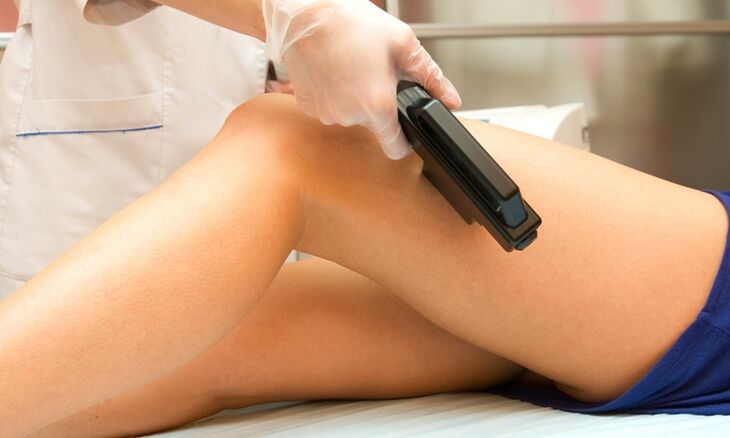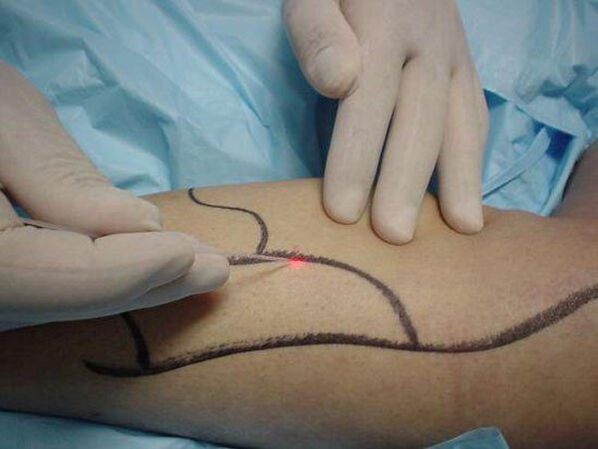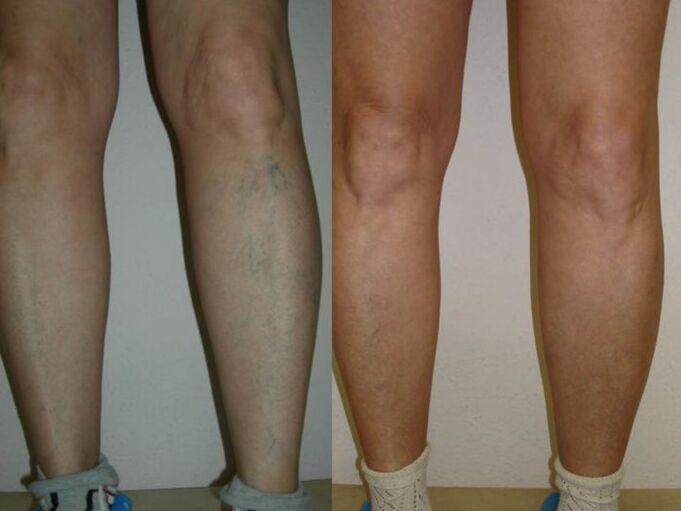Varicose veins of the legs are a common pathology that occurs in people of various genders and ages, regardless of country of residence. For a long time, the only way to get rid of varicose veins of the lower extremities was surgery. But today doctors offer a painless and effective method - laser treatment of varicose veins.
The essence of this procedure is that through the introduction of a special light path into the vessels, under its influence, the damaged vessels will stick together, and blood flow will be directed through the healthy veins. If we consider alternative therapies, then:
- classical venous removal (surgery to remove the vein) is characterized by pain and trauma, there is a risk of infectious complications;
- removing only part of the diseased vein (microsurgery) leaving a scar on the skin;
- sclerotherapy causes allergies in some cases.
Considering the listed disadvantages that laser lacks, laser varicose vein treatment is said to be the best option compared to those currently available. Doctors have been practicing this method for more than 10 years, and during this time, laser coagulation has not caused any complaints. Not everyone can afford the price, but taking into account the effectiveness of this procedure, you can completely accumulate the necessary amount or take out a loan.
Indications for laser coagulation
The procedure is indicated in the case of dilated large and small hemisphere veins. Furthermore, the dilation of the vascular layer should not exceed 1 cm, and the veins themselves should be mostly even, without sharp bends. The branches of the leaf veins should be healthy or slightly stretched. In other words, laser coagulation is effective in the early stages of varicose veins, when the severity is small, and this applies only to superficial veins. As for veins that are more than 1 cm dilated, they can also be "glued" with a laser, but there is a risk in the future that the vessel will not stick again and all treatment will go to waste.

The laser acts on a small area to eliminate the negative impact on the adjacent tissues. For this reason, in the case of significantly damaged blood vessels and deep veins, lasers are not effective. In such situations, choose one of the classic methods listed above.
Contraindications for laser treatment
In addition to the cases listed above, when this technique becomes less effective, laser varicose vein treatment with endovasal is contraindicated in situations where it may be harmful to the patient. There are enough contraindications, and they are all divided into relative and absolute.
Relative ones include contraindications that only at this time do not allow to perform the operation. It can be burns and inflammation on the skin, exacerbation of chronic pathologies. It is necessary to treat the current definitively, then proceed to laser vein removal. If you do the opposite, there is a high risk of complications. Pregnancy and hepatitis B are also considered relative contraindications, because during this period the body is weakened, the burden on the legs is great. Due to the blockage of the veins of the lower extremities, the operation is not performed in obese people - there is a possibility of complications.
The absolutes include contraindications, therefore a person is forbidden to have laser removal. These are the following states:
- damage to the walls of blood vessels;
- disturbances in the outflow of lymph and blood in the legs;
- thrombophlebitis and propensity to thrombus formation.
Against the background of such conditions, the laser can cause venous thrombosis and damage the blood vessels. Other contraindications are related to a person's lifestyle - if you can't be active and wear compression underwear in the near future (after surgery), the pulse may become inflamed, and the treatment will not be effective.
How is the procedure done?
Laser treatment of varicose veins in the legs is done on an outpatient basis. There is no need for local or general anesthesia because the affected area is very small and the process takes place inside the blood vessel. If necessary, you can take a sedative as recommended by your doctor if you are afraid of surgery. The essence of the procedure:
- A small incision is made in the skin of the leg, through which a light guide is inserted into the damaged vein. This fixture will emit laser light at a controlled wavelength;
- due to radiation, blood is forced out of the damaged vein;
- Under the action of the laser, the vessel walls stick together, blood no longer circulates here.
Typically, laser treatment takes up to 90 minutes. After the damaged veins are sealed, blood is directed through the deep veins located inside the muscle. After such a procedure, there are no scars and hematomas.
Benefits of laser therapy
As mentioned at the beginning of the article, compared with other methods, the laser varicose vein removal method has many advantages. Everyone should know about the main advantages:
- no need to go to the hospital, since the procedure is done on an outpatient basis, the same day you can go home;
- the procedure gives the best cosmetic effect, since the doctor accesses the affected vein through a small puncture in the skin, which then heals without scarring and scarring;
- Modern laser equipment disperses radiation well, allowing high-quality treatment inside the vessel. This eliminates the risk of bleeding and bruising;
- can immediately remove the veins on both legs;
- The recovery time is very quick and painless. An hour after the procedure, you can go home, and after a few days - live the same.

Considering the listed advantages of this approach, it is clear why laser coagulation varicose vein treatment is recognized as the most effective and safe. Thereafter, there were no thrombophlebitis and secondary infection, scarring and discomfort, complications and recurrence.
Disadvantages of laser vein treatment
Any medical manipulation has its advantages and disadvantages. When it comes to removing leg veins, laser treatment isn't always without results. More precisely, before the procedure, you need to familiarize yourself with the possible difficulties and disadvantages of the technique:
- severe stage of varicose veins not treated with laser;
- with a large diameter of the damaged vessel, laser therapy is combined with surgery, and one cannot do without incisions and incisions in the skin;
- Laser treatment of varicose veins involves wearing compression hosiery for a week (at least) after surgery, which is not for everyone;
- The main disadvantage is considered by many to be the high price for laser procedures.
After weighing the stated pros and cons, you can discuss with your doctor the best way to treat varicose veins in a particular case.
Rehabilitation
There is no special way to restore health after laser vein coagulation. The patient quickly returned to a normal life. No need to be hospitalized, even lying in bed. The same can be said about the use of antibiotics, physiotherapy procedures and the tightly bandaged, mummy-like foot - the modern procedure is completely free of these shortcomings.
At the end of the operation, the doctor let the patient lie down gradually. First, you need to sit on the couch for a while to normalize your condition, then you can get up. Do not get up strongly after an hour lying on the chair, because it can cause a pulse, dizziness, etc. v.
Patients do not feel pain in their legs when transferring their weight to them. The only thing that might bother you is a slight tingling sensation in the place on your leg where the light tube was inserted. Since there is no pain syndrome, you do not need to take pain medication.

A prerequisite for the recovery period will be wearing compression knitwear. The duration of wearing such underwear and the degree of its compression should be discussed separately with the doctor. Thanks to the compression knit material, puffiness is eliminated and blood flow through the superficial veins is stopped, the role of which is taken up by the deep blood vessels. The pre-purchased compression garment will be placed on the patient's feet directly in the operating room after the end of the laser coagulation.
For the first 2 days after the procedure, the compression knit will be left on the leg even at night, then worn during the day for the entire time recommended by your doctor and removed during the day. night. Given that tight pants will warm the body, you should do this procedure in the cold season. This way, you can avoid discomfort and don't need to wear tights on hot days.
Unlimited physical activity - you can walk without assistance. The only thing not to do with varicose veins and after surgery is lifting weights. During the first week, it is not recommended to visit the sauna and steam room in the bath. In the future, you can safely walk long distances, drive a car, and carry out your daily activities.
General recommendations for all who have experienced varicose veins in the legs are as follows:
- control body weight, since extra weight is a load on the spine, heart and blood vessels;
- Avoid static postures. If your occupational activity involves prolonged sitting or standing, you need to take breaks and warm-up from time to time;
- you can not sit cross-legged - this constricts blood vessels;
- permanently quit smoking;
- shoes should be comfortable, women's heels - up to 5 cm high;
- normalize the daily routine, supplement it with daily walks and regular exercise.
Adhering to the listed recommendations, you can prolong the effect of the activity for a long time.












































